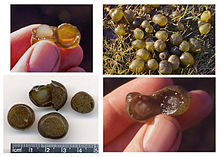Our website is made possible by displaying online advertisements to our visitors.
Please consider supporting us by disabling your ad blocker.
Nostoc pruniforme
| Mare's eggs | |
|---|---|

| |
| Scientific classification | |
| Domain: | Bacteria |
| Phylum: | Cyanobacteria |
| Class: | Cyanophyceae |
| Order: | Nostocales |
| Family: | Nostocaceae |
| Genus: | Nostoc |
| Species: | N. pruniforme
|
| Binomial name | |
| Nostoc pruniforme C.Agardh ex Bornet & Flahault
| |
Nostoc pruniforme (Mare's eggs) are a species of cyanobacterium. These freshwater bacteria grow in colonies which take the form of dark green, gelatinous spheres with a smooth surface like a plum. It is common and widely distributed both geographically and ecologically in oligotrophic and mesotrophic freshwaters in temperate and sub-Arctic regions.[1]
In temperate lakes, N. pruniforme appears to grow in diameter from ~0·2 cm in late spring to 2–3 cm in midsummer and it can rapidly die off, supposedly because of attacks by viruses or bacteria at high summer temperatures (K. Sand-Jensen, unpubl. data). In contrast, in a cold (4 °C), nutrient-poor spring in Oregon, USA, N. pruniforme reached a handball size of 15–17 cm in diameter and weighed 2.6 kg after sustained slow growth for 9–14 years.[2] Very large colonies are also found in cold transparent lakes in Greenland (K. Sand-Jensen, unpubl. data). In addition to their larger size and persistence, they differ from Danish temperate specimens by having a more solid surface and a denser gel.
- ^ Sand-Jensen, Kaj (July 2014). "Ecophysiology of gelatinous Nostoc colonies: unprecedented slow growth and survival in resource-poor and harsh environments". Annals of Botany. 114 (1): 17–33. doi:10.1093/aob/mcu085. ISSN 1095-8290. PMC 4071103. PMID 24966352.
- ^ Dodds, Walter K.; Castenholz, Richard W. (September 1988). "Effects of grazing and light on the growth of Nostoc pruniforme (Cyanobacteria)". British Phycological Journal. 23 (3): 219–227. doi:10.1080/00071618800650251. ISSN 0007-1617.
Previous Page Next Page


